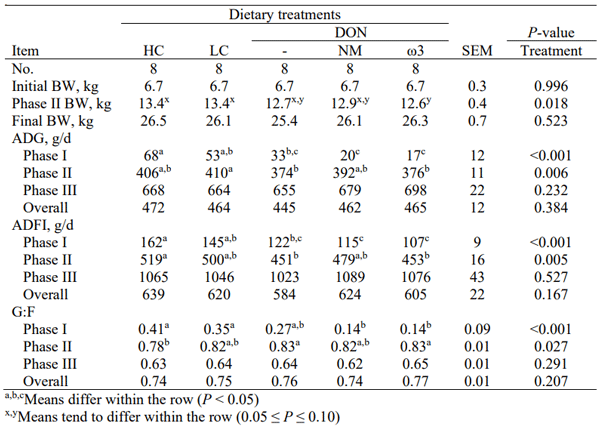The Effects of Supplementing Low-Complexity Deoxynivalenol-Contaminated Nursery Diets with NutraMix™ or Fish Oil on Growth Performance and Immune Function
It is standard to feed newly weaned pigs high-complexity nursery diets to combat the growth lag induced by stressors of the weaning process. These nursery diets contain multiple sources of highly digestible animal-based proteins, making them the most expensive diets in the production cycle. Pigs can accelerate growth following a period of reduced growth caused by nutritional challenge (including the use of plant-based protein sources), which is known as compensatory growth. Feeding low complexity nursery diets containing increased inclusion of plant-based ingredients may be a means to decrease nursery feed costs, but with greater risk for mycotoxin contamination, which could inhibit compensatory growth. The objective was to evaluate the effects of deoxynivalenol (DON)-contaminated low-complexity diets supplemented with NutraMix™ or fish oil on growth performance and immune response. 320 newly weaned pigs were assigned to either a [1] high-complexity, [2] low-complexity or [3] DON-contaminated (3 ppm) low complexity diet without additive, [4] with NutraMix™ (0.2%) or [5] fish oil (2.5%) for 3 weeks. Thereafter, an E. coli lipopolysaccharide (LPS) challenge was performed, and the remaining pigs were fed a common, uncontaminated diet for 3 additional weeks. Though DON-contaminated low complexity diets initially reduced growth performance, all pigs achieved the same final body weight (26.1 kg) following the recovery period. During the LPS challenge, pigs fed NutraMix™- supplemented diets had increased relative liver weights and improved interferon-γ response compared to pigs fed the other DON-contaminated diets. Therefore, nursery pigs can express compensatory growth after exposure to diets containing 3 ppm DON. This indicates that low complexity diets could be used to reduce feed costs, even when DON is present in cereal grains. NutraMix™ may improve the immune response during a disease challenge and when feeding DON-contaminated low-complexity diets.
Key words: Nursery pigs, compensatory growth, deoxynivalenol.


Campbell, R. G. and A.C. Dunkin. 1983. The influence of protein nutrition in early life on growth and development of the pig: 1. Effect on growth performance and body composition. British J. Nutr. 50:605-617. doi:10.1017/S0003356100010461
Chen, C. C., T. T. Lee, C. Bin Hsu, C. W. Huang, and B. Yu. 2011. Associations of allergenic soybean proteins with piglet skin allergic reaction and application of polyclonal antibodies. Anim. Prod. Sci. 51:1008-1014. doi:10.1071/AN11142
Huber, L., S. Hooda, R. E. Fisher-Heffernam, N. A. Karrow, and C. F. M. de Lange. 2018. Effect of reducing the ratio of omega-6-to-omega-3 fatty acids in diets of low protein quality on nursery pig growth performance and immune response. J. Anim. Sci. 96:4348-4359. doi:10.1093/jas/sky296
Jin, L., W. Wang, J. Degroote, N. Van Noten, H. Yan, M. Majdeddin, M. Van Poucke, L. Peelman, A. Goderis, K. Van De Mierop, R. Mombaerts, S. De Smet, and J. Michiels. 2017. Mycotoxin binder improves growth rate in piglets associated with reduction of toll-like receptor4 and increase of tight junction protein gene expression in gut mucosa. J Anim. Sci. Biotechnol. 8. doi:10.1186/s40104-017-0210-4
Lallès, J. P., G. Boudry, C. Favier, N. Le Floc’h, I. Luron, L. Montagne, I. P. Oswald, S. Pié, C. Piel, and B. Sève. 2004. Gut function and dysfunction in young pigs : physiology. Anim. Res. 53:301-316. doi:10.1051/animres:2004018
Rodrigues, I., and K. Naehrer. 2012. A Three-Year Survey on the Worldwide Occurrence of Myctoxins in Feedstuffs and Feed. Toxins. 4:663-675. doi:10.3390/toxins4090663
Rotter, B. A., B. K. Thompson, M. Lessard, H. L. Trenholm, and H. Tryphonas. 1994. Influence of low-level exposure to Fusarium myctoxins on selected immunological and hematological parameters in young swine. Fund. Appl. Toxicol. 23:117-124. doi:10.1006/faat.1994.1087
Skinner, L. D., C. L. Levesque, D. Wey, M. Rudar, J. Zhu, S. Hooda, and C. F. M. de Lange. 2014. Impact of nursery feeding program on subsequent growth performance, carcass quality, meat quality, and physical and chemical body composition on growing-finishing pigs. J. Anim. Sci. 92:1044-1054. doi:10.2527/jas2013-6743
Van Le Thanh, B., M. Lessard, Y. Chorfi, and F. Guay. 2015. The efficacy of anti-mycotoxin feed additives in preventing the adverse effects of wheat naturally contaminated with Fusarium mycotoxins on performance, intestinal barrier function and nutrient digestibility and retention in weaning pigs. Can. J. Anim. Sci. 95:197-209. doi:10.4141/CJAS-2014-126






